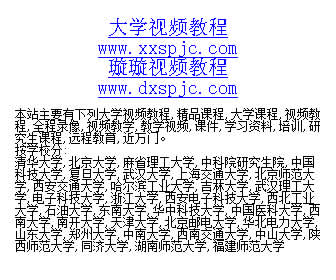![《干细胞的调控网络 --干细胞生物学和再生医学》(Regulatory Networks in Stem Cells )[PDF]](http://pic.dxspjc.com/dx_pic/9122212/2330871.jpg)
◎类 别 论文集锦
◎页 码 1126页
【内容简介】
关于这本书
这本书雄心勃勃地融合了所有关于胚胎,组织最新的分子调控和重要课题,癌症干细胞。关于病理和治疗章也相当丰富。
【推荐】
我高度赞赏所有捐助者的编辑和严格的努力,并强烈推荐这本书的专家以及学生。
--山中伸弥博士,日本京都大学
这一新的卷提供了干细胞再生和分化,从作者的专家小组规定的广泛的多样化的概述。各章涵盖了分子生物学和模型系统的课题种类繁多,给干细胞研究及临床意义。本书将是有益的,向学生和外地经验的研究人员。
--马丁佩拉,南加州大学,加州洛杉矶大学。美国。
干细胞应用'思想'和干细胞科学发展生物学,以组织的平衡,以及对癌症的一代造成了新的实验爆炸,在过去几年的新模式。知识的积累率超过了大多数科学家的能力,特别是老化的科学家,消化阅读的主要文献。这里Rajasekhar和Vemuri已聚集了世界各国领导人的文章和评论的干细胞研究的所有领域-组织和器官[成人]干细胞和祖细胞,癌症干细胞,古典胚胎多能干细胞,多能干细胞,并导出了核重新规划成熟的成年体细胞的细胞核。它甚至涵盖了诱导多能干细胞领域的快速突破[能干]细胞,体细胞,这些由低至3个基因,其基因产物能重新转重新规划设置了多能干细胞的成熟细胞的基因组了这一点。在所有这些领域的潜力,研究,并开始了解人类发育生物学,从与多能干细胞产生遗传疾病的病人,可以使在该疾病影响的细胞类型,并与组织和器官的干翻译的企图明显细胞承诺使这些办法,在这本书的审查,在再生医学中心的研究。癌症在各种癌症有他们[没有干细胞的癌症干细胞识别,但瘤细胞亚群的重新生成整个肿瘤,而自我更新]必将有助于为药物治疗和新确定的信号显像剂的目标他们利用转导通路,并以新颖的蛋白质和多肽免疫指标[至少]这也造成了突变,易位和剪接异常中心在这些癌症干细胞致癌进展。这本书是一个重要除了科学家和机构做图书馆和教干细胞研究。我赞扬了出色和令人兴奋的书的编辑和作者。
--欧文韦斯曼博士,斯坦福大学
![《干细胞的调控网络 --干细胞生物学和再生医学》(Regulatory Networks in Stem Cells )[PDF]](http://pic.dxspjc.com/dx_pic/9122212/2330801.jpg)
![《干细胞的调控网络 --干细胞生物学和再生医学》(Regulatory Networks in Stem Cells )[PDF]](http://pic.dxspjc.com/dx_pic/9122212/2330894.jpg)
【About this book 】
This book ambitiously incorporates all the latest and essential subjects on molecular regulation in embryonic, tissue, and cancer stem cells. The chapter on pathology and therapy is also fairly informative.
I highly appreciate rigorous effort by all the editors and contributors, and strongly recommend this book to experts as well as students
-- Dr. Shinya Yamanaka, Kyoto University, Japan
This new volume provides a broad overview of the regulation of stem cell renewal and differentiation from a diverse panel of expert authors. The chapters cover a remarkable range of topics, from molecular biology and model systems to translational and clinical implications of stem cell research. The book will be useful to both students and experienced researchers in the field.
-- Dr. Martin Pera, University of Southern California, Los Angeles, CA. USA.
The application of stem cell 'thinking' and stem cell science to the biology of development, to tissue homeostasis, and to the generation of cancers has resulted in the explosion of new experiments and new models over the past several years. The rate of knowledge accumulation exceeds the abilities of most scientists, and especially aging scientists, to digest by reading the primary literature. Here Rajasekhar and Vemuri have brought together essays and reviews by world leaders in all areas of stem cell research--tissue and organ [adult] stem and progenitor cells, cancer stem cells, classical embryonic pluripotent stem cells, and pluripotent stem cells derived by nuclear reprogramming of adult somatic mature cell nuclei. It even covers the fast breaking field of induced pluripotent stem [iPS] cells, somatic cells that were reprogrammed by the transfection of as little as 3 genes whose gene products can re-set the genome of a mature cell to that of a pluripotent cell. The potentials of all of these areas to study and begin to understand human developmental biology, to produce from patients with genetic diseases pluripotent stem cells that can make all of the cell types affected in the disease, and the obvious translational attempts with tissue and organ stem cells promises to make these approaches, and the reviews in this book, the center of research in regenerative medicine. The identification of cancer stem cell in those cancers that have them [not cancers of stem cells, but the intratumoral cell subset that regenerates the entire tumor while self-renewing] will certainly help provide targets for drug therapies and novel imaging agents in the identified signal transduction pathways they use; and immunotherapy targets by the novel proteins and peptides [at least]that are created by mutations, translocations, and splicing anomalies central to the oncogenic progression in these cancer stem cells. The book is an essential addition to the libraries of scientists and institutions that do and teach stem cell research. I commend the editors and authors for an excellent and exciting book.
- -Irv Weissman MD, Stanford University
目录:
Part I Molecular Regulation in Stem Cells
Part II Regulation by Stem Cell Niches
Part III Epigenetic Mechanisms in Stem Cells
Part IV Signaling and Regulation in Select Stem Cell Types
Part V Disease Paradigms and Stem Cell Therapeutics
Index

